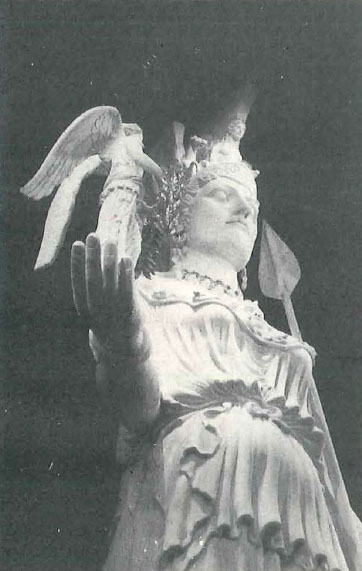Athens is not alone in having a Parthenon. In 1889, to commemorate the centennial of its entry as a state into the Union and to promote the city’s claim to being the ‘Athens of the South’, a centre of culture and education, Nashville, Tennessee, commissioned the building of a full-scale replica of the Parthenon.
That the new Parthenon, when finished, stood at the centre of a flat, green park, beside a lake with swans, bothered no one in Nashville. The Parthenon itself had been built, in consultation with archaeologists, as exact to the Parthenon in Athens as possible.
If nothing else, it could at least claim to being the world’s most complete Parthenon. And yet, something was missing. The inside, except for a few casts of the pediment sculptures in the British Museum, was empty.
A decade ago, city leaders began discussing the possibility of building a statue of the goddess of wisdom, like the one in the original Parthenon, to grace the inside. A competition was held, models were submitted, and a local sculptor, Alan Le Quire, was chosen.
Le Quire, who had studied classical art in Italy, read the description of the original statue in Pausanias. He consulted with classical scholars. He made more sketches, closely following existing ones on coins and miniatures of Athena Parthenos of the Roman period.
Yet he departed from that model in several ways. He dispensed with the column holding Nike, the goddess of victory. It distracted from Athena and was unnecessary with today’s technology for support. He put her right hand, the one holding Nike, out more to the side so that it would not block the view of the whole figure of Athena. He added a spear, the weapon the warrior goddess frequently carried, and tucked in the drapery at her waist, making her more feminine. This gave rise to scandalous gossip in Nashville that the virgin goddess might be pregnant.
Technically, Le Quire added four invisible steel ‘back bones’, stretching from inside her head down into the earth beneath the temple, making the 42-foot statue, which weighs more than 12 tons, ‘earthquake proof’. He dispensed with the idea of a reflecting pool in front of Athena. The interior is lit with electricity, not torches, and there is no precious ivory to keep from cracking. This Athena is made of gypsum cement plaster, reinforced with fiberglass.
On May 20, 1990, after seven years of work on Le Quire’s part, who received only 1000 US dollars a month for what he describes as a ” labor of love”, the statue was finally unveiled. That morning it rained cats and dogs in Nashville. Officials called off the outside events: the Greek-American dancers, and the skydiving. Just before the ceremonies were to begin at 2:00 pm, however, the weather began to clear. Within a large revival-style tent in front of the east entrance, country music star Loretta Lynn sang. Nashville, as everyone knows, is also America’s capital of country music.
Then, former King Constantine, who had attended a 500 dollar-a-plate sponsors’ dinner the previous evening, told the audience that Greeks everywhere welcomed the statue and asked his son Paul to rise to the audience and be recognized. After viewing Athena, father and son were whisked away in a long black Lincoln limo to the Nashville airport, where they boarded the king’s private jet and flew back to London.

More speeches were delivered. A time capsule bearing the names of donors, it was announced, had been placed inside the head of Athena. A ten-gun salute to the goddess of civic virtue shook the tent as a city official asked everyone in the audience to honor the city’s new spiritual guardian by silently pledging to do something for Nashvillle. The ceremony concluded with a spirited recital from Homer of a hymn of praise for the bright-eyed goddess.
At 3:00 pm, the time everyone had been waiting for, the east door of the Parthenon swung open and the crowd, more than two thousand strong, jostled for a view, but in reverential silence as if they were in church. Athena was stern, a warrior, yet decidedly a goddess.
She was also as exact a replica as it was possible, down to the familiar scene on the soles of her sandals of the battle between the Lapiths and Centaurs, the eternal struggle between Civilization and the Barbarians. Phidias would certainly have approved. Concerts continued into the evening, climaxing in a grand show of fireworks, and the following evening a panel of distinguished scholars debated on the significance of the occasion. Even the goddess of wisdom would have been amazed.
Wilson Strand is Associate Professor of Greek History at Southwest State University, Marshall, Minnesota. Professor Strand, who taught for over eight years at several colleges and institutes in Athens and Thessaloniki, considers Greece his second home.







